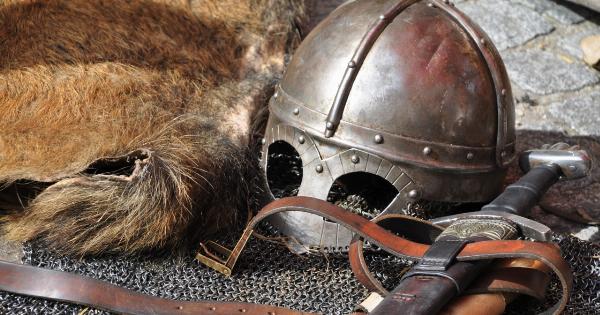Anemia is a condition characterized by a shortage of red blood cells or decreased hemoglobin levels in the blood. It is one of the most common blood disorders affecting millions of people worldwide.
Iron deficiency anemia, in particular, is a prevalent form of anemia caused by a lack of iron in the body. In this comprehensive guide, we will explore the causes, symptoms, and treatment options for iron deficiency anemia, along with images to help you identify the condition.
Understanding Iron Deficiency Anemia
Iron plays a crucial role in the production of hemoglobin, a protein responsible for carrying oxygen to various tissues and organs in the body.
When your body lacks sufficient iron, it cannot produce an adequate amount of hemoglobin, leading to iron deficiency anemia.
 .
.
Causes of Iron Deficiency Anemia
There are several factors that can contribute to iron deficiency anemia:.
1. Inadequate Dietary Intake
Not consuming enough iron-rich foods can significantly impact your iron levels. Foods rich in iron include red meat, liver, green leafy vegetables, beans, and fortified cereals.
 .
.
2. Malabsorption
Diseases like celiac disease, inflammatory bowel disease, and gastric bypass surgery can hinder iron absorption in the body, leading to anemia.
3. Blood Loss
Chronic blood loss due to conditions like heavy menstrual periods, gastrointestinal bleeding, or peptic ulcers can result in iron deficiency anemia over time.
 .
.
4. Increased Iron Requirements
Pregnant women, infants, and growing children have higher iron requirements, and if these needs are not met, it can lead to anemia.
Identifying Iron Deficiency Anemia
Iron deficiency anemia can manifest through various symptoms, some of which include:.
1. Fatigue and Weakness
One of the most common symptoms of iron deficiency anemia is feeling constantly tired and lacking energy to perform daily activities.
 .
.
2. Pale Skin and Brittle Nails
Anemia causes a decrease in red blood cells, which can result in paler skin and brittle, spoon-shaped nails.
3. Shortness of Breath
Due to reduced oxygen-carrying capacity, individuals with iron deficiency anemia may experience difficulty in breathing and feel breathless even with minimal exertion.
 .
.
4. Restless Legs Syndrome
Iron deficiency anemia has been associated with restless legs syndrome, a neurological disorder characterized by an uncontrollable urge to move the legs.
Diagnosing Iron Deficiency Anemia
If you suspect you may have iron deficiency anemia, it is essential to seek medical advice for a proper diagnosis. A physician will typically perform the following tests:.
1. Blood Tests
A complete blood count (CBC) is the primary test used to measure hemoglobin levels and identify red blood cell deficiencies. Additionally, serum ferritin levels are checked to assess iron stores in the body.
 .
.
2. Additional Tests
In some cases, further tests like iron-binding capacity, transferrin saturation, and iron level measurements may be conducted to confirm the diagnosis and identify the underlying cause.
Treatment Options for Iron Deficiency Anemia
Iron deficiency anemia is treatable, and the choice of treatment depends on its cause and severity. Common treatment options include:.
1. Iron Supplements
Oral iron supplements in the form of ferrous sulfate, ferrous fumarate, or ferrous gluconate are often prescribed to replenish iron stores in the body.
 .
.
2. Dietary Modifications
Incorporating iron-rich foods and vitamin C in your diet can help enhance iron absorption. Vitamin C helps convert iron into a more absorbable form, so including citrus fruits, berries, and leafy greens in your meals can make a difference.
3. Blood Transfusion
In severe cases where iron deficiency anemia is life-threatening or doesn’t respond to other treatments, a blood transfusion may be required to rapidly increase hemoglobin levels.
 .
.
Preventing Iron Deficiency Anemia
Prevention is key when it comes to iron deficiency anemia. Here are some tips to maintain healthy iron levels:.
1. Balanced Diet
Include a variety of iron-rich foods in your meals, such as lean meats, fish, legumes, nuts, seeds, whole grains, and leafy green vegetables.
 .
.
2. Vitamin C Intake
Pair iron-rich foods with sources of vitamin C, like oranges, strawberries, tomatoes, or bell peppers, as this can improve iron absorption.
3. Avoid Excessive Tea and Coffee Consumption
Tannins present in tea and coffee can hinder iron absorption. Limit your intake, especially around mealtimes.
 .
.
Conclusion
Iron deficiency anemia is a common blood disorder caused by a shortage of iron in the body, leading to decreased hemoglobin production. Recognizing the symptoms and getting a timely diagnosis is crucial for effective treatment.
By implementing dietary changes, taking iron supplements, and seeking medical advice, it is possible to overcome this condition and restore optimal iron levels in your body.





























